Line Cruiser Rivalry: Derflinger vs. Tiger
History Derflinger was launched in April of 1910, when the design bureau requested technical requirements for battleships and cruisers planned for construction under the 1911 program. The response of the maritime ministry ... let's say, was very intriguing.
It stated that at present it is impossible to put forward such requirements, because there are two, let's say, extremely important innovations for the future of the German military shipbuilding: these are three-gun towers (!) And diesel engines (!!), but the study of the possibilities of their application will last until 1910 Winter
However, Vice-Admiral Pashen had a special opinion on this matter and pointed out one mandatory innovation for the 1911 program cruiser of the year - the transition to the 305-mm caliber. Pashen absolutely rightly believed that the double difference in the weight of the shells (“302 kg versus 600 kg”, obviously, did not yet know the exact weight of the English 343-mm guns in Germany) completely unacceptable. Therefore, he considered it necessary to install on the next 10 305-mm guns, either in the center plane or in a diagonal pattern a la "Seidlits". However, Pashen also advocated the installation of diesel engines (the author of this article is not quite sure about the translation, but it was probably not a complete replacement, but only the installation of diesel engines of the economic course).
Then, Secretary of State von Tirpitz initiated a series of meetings on how to be the newest German ships, the first of which took place on 11 in May 1910. Rear Admiral Jerdes (Gerdes), speaking from the weapons department, reported that, according to research, German 280-mm guns will not be effective weapons at a distance of 8-000 m (10-000 kbt) against British battlecruisers with 43 mm of armor. At the same time, Rear Admiral reminded the meeting that the German battlecruisers, in fact, were intended not only and not so much against the English "classmates" as as a high-speed wing fleet. As such, they would have to meet with British battleships, the last series of which already had 305 mm side armor. Based on the foregoing, Gerdes made the very obvious conclusion that the 280 mm caliber has outlived itself: at the same time, Rear Admiral indicated that replacing 10 mm guns with 280 mm will cause an increase in artillery weight of only 8 tons.
Oddly enough, von Tirpitz completely disagreed with Djerdes. According to the state secretary, even if the battle starts on 45-55 cable, the distance would very quickly be reduced, and there ten 280-mm guns will be more effective compared to eight 305-mm. Surprisingly, von Tirpitz supported Paschen, who had previously argued in his memorandum the need to switch to a twelve-inch caliber. Eleven inches were supported by the shipbuilding department. All this allowed Von Tirpitz to announce that he is still stopping at the 280-mm caliber, despite the fact that the newest German Dreadnoughts have already switched to the 305-mm cannon. But even more important than weapons, he believes the need to change the power plant, namely - the transition from turbines to diesel. The construction of diesel battleships and battlecruisers under the 1911 g program was what, according to the State Secretary, it was necessary to strive with all forces because this would allow the Kaiserlichmarine to make a huge step forward in comparison with the rest of the world’s fleets.
In other words, in the early stages of development, the main persons in charge saw the future battlecruiser of Germany completely different from what it turned out to be: they wanted to get a diesel ship with 280-mm artillery!
Fortunately, common sense gradually prevailed. The design bureau did not consider the options with 280-mm artillery optimal and "blew off dust" from the 305-mm cruiser of the 1910 shipbuilding program of the 280 g. Then it failed (the 305-mm "Zeidlits" was laid), but now the shipbuilders were more successful. Created by the end of May, a draft design of a four-erected battle cruiser with 280-mm artillery, and a month later, another one, with the towers in the center plane, finally found a path to the heart of von Tirpitz: he no longer insisted on ten XNUMX-mm guns .
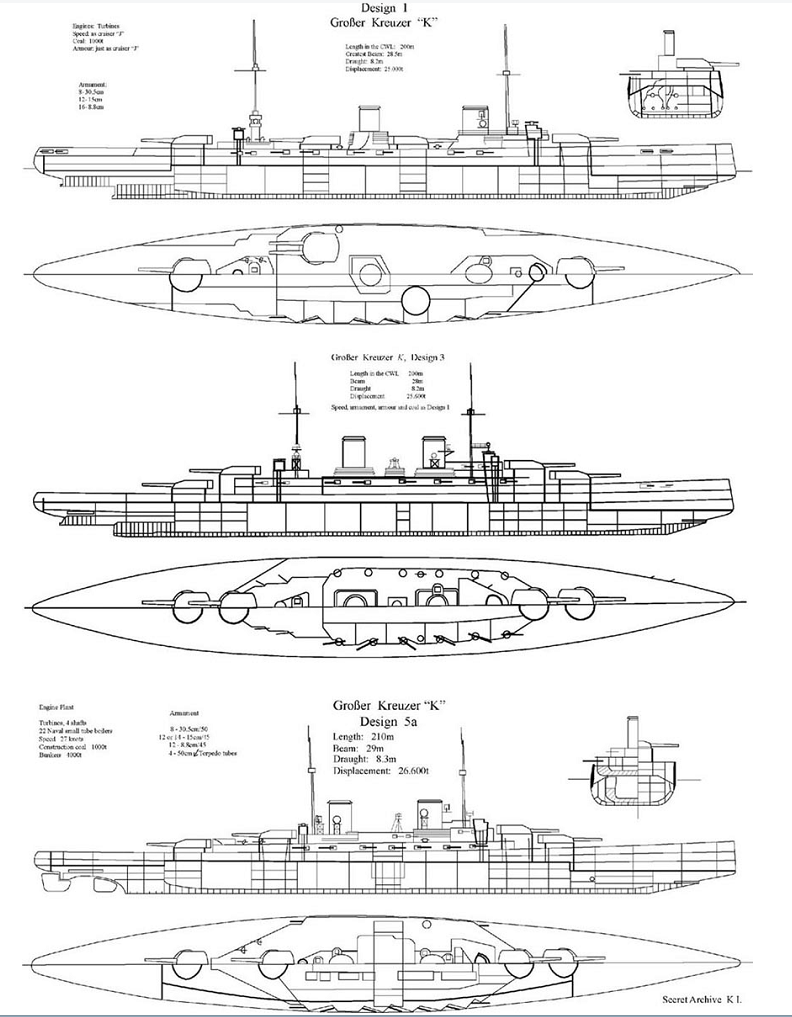
However, the state secretary continued to demand the installation of diesel engines, but here the issue was resolved by itself - in September 1910 g found out that MAN was not yet able to create diesel engines for such large ships, so they had to return to the turbines.
Deciding for himself the need to switch to 305-mm caliber, von Tirpitz continued to be a supporter of ten guns on the battlecruiser, and therefore at 1 September, 1910 proposed to revise existing projects in order to add a fifth tower of 305-mm guns . But it was not possible to do this - the displacement of the ship grew too much. We stopped at four towers, but the question arose of their placement - as a result, the meeting concluded that the location of the four towers in a linearly elevated pattern (that is, as in Derflinger) has a preference, but only if the second tower can fire on top of the first, and the third - respectively, on top of the fourth. In this case, it will be possible to concentrate heavy fire on the bow / stern - but if shooting over the tower proves impossible, then you should return to the diagonal scheme and place the towers like they were installed in Fon der Tanna.
Further design of the ship went quite smoothly, along the path of consistent improvement of the project. On the whole, the following can be said: having created the “Fon der Tann”, the Germans made a qualitative leap, but the ships of the Moltke and Seidlitz series that followed it were an evolutionary development of the first full-fledged German battle cruiser. Creating the “Derflinger” the Germans, one might say, created the next generation of German ships of this class.
Chassis
The case of the “Derflinger” was distinguished by several innovations, and the first of them is a longitudinal set, first used by the Germans on heavy warships. This design provided acceptable strength while saving weight. Probably, for this reason, the distance between the spurs has decreased - instead of the classic 1,2 for the German fleet, this distance on the Derflinger was 0,64. In all previous articles of the cycle, we did not pay attention to such details, but the fact is that in foreign literature ( and not only in it) they often measure the length or the location of one or another structural element (for example, the armor belt) by means of spacations, therefore this distinction of the “Derflinger” from other German ships should be known.
The ship had a large metacentric height, and it had its advantages - for example, when turning the roll angle was relatively small, so that the lower edge of the armor belt did not come out of the water, exposing the unprotected board. But there was also an important drawback - a small period of pitching, which would make it much less smooth in comparison with the same ship with a smaller metacentric height. At the same time, the quality of a warship as an artillery platform is largely determined by the smoothness of pitching - it is clear that the less its influence, the easier it is to point the gun at the target. Therefore, "Derflinger" equipped with a system of calm pitching - Fram tanks. In principle, it was placed on battlecruisers before, but, as far as it is possible to understand the descriptions in the sources, it wasn’t used on the same “Zeidlitsa” for its intended purpose, but on the “Derflinger” it seemed to work.
If you look at the photos or drawings of the “Derflinger” and “Seidlitz”, the first one looks more low-boring, but this is not so - the board height of the “Derflinger” was 14,75 m in the middle, with an average draft of 9,38 m (9,2 m - nose, 9,56 m - aft) gave the height of the board over the 5,37 waterline, m. At the “Seydlitz”, the mid-board height was 13,88 m, the bow / slump - 9,3 / 9,1 m, respectively, the average draft of 9,2 m and the height of the board over the 4,68 waterline, m smaller than Derflinger. Obviously, this is a matter of a small visual deception - the fact is that the “Seydlitz” had a forecastle, which was attached to the casemate, located on the upper deck. As a result, the Zeydlitz casemate is visually perceived as part of the board, while for the Derflinger bar, which lacks the forecastle, the casemate looks like a separate superstructure, which has nothing to do with the height of the board.
But Derblinger did not have a forecastle - in order to facilitate the hull structures, instead of using it, we used deck lifting in the bow and stern, which gave the linear cruisers of this type a very beautiful and memorable silhouette. True, not the fact that added seaworthiness (we'll talk about it below), but in any case, such an indicator as the height of the freeboard at the stem of the “Derflinger” almost did not yield to that of the “Seydlitz” - 7,7 m against 8 m.
Reservation
Vertical booking “Derflinger was traditionally powerful. Only the last 4,5 meters of the stern were unprotected by armor - from them to the side of the nose for 33,3 meters the board was protected by 100 mm armor, closely adjacent to the citadel. The citadel itself, 121,5 m long, consisted of a 300 mm section of 2,2 m height, of which 40 cm were under the waterline, and the thickness of the armor plates traditionally decreased to the bottom edge to 150 mm.
Above the 300 mm section of the board the height of the 3 550 mm was defended by 270 mm with armor, only to the upper edge the thickness dropped to 230 mm. Thus, the total height of the Derflinger armored side in the citadel area was 5 750 mm, of which 400 mm were below the waterline. Of course, the citadel traditionally closed not only the boiler rooms and machine rooms, but also the 305 mm cellars of the towers, including the extreme ones. From the citadel to the nose for 19,2 m, the board was reserved with 120 mm plates and then to the stem - 100 mm.
The citadel was closed by traverses, 226-260 mm in nose and 200-250 mm in stern, while at the end of the 100 mm belt in the stern (as we said above, it left the 4,5 mm board unprotected).
The armored deck within the citadel had a 30 mm in the horizontal part, but in the areas of the towers of the main caliber thickened to 50 mm - the same thickness (50 mm) had bevels. Outside the stronghold of the fortress, it was located below the waterline and had a thickness of 80 mm in the stern and 50 mm in the bow.
In addition to armor, the upper deck (thickness 20-25 mm), as well as the casemate roof, which had a variable booking thickness 30-50 mm (unfortunately, where the 50 mm was, the author could not figure it out) could provide some protection.
Artillery armor has once again been reinforced: the forehead of the Derflinger towers defended 270 mm armor (Seidlitz had 250 mm), sides 225 mm (200), sloping front roof 110 mm (100) of the horizontal roof 80 mm (70). The thickness of the barbetts increased from 230 to 260 mm in the same places where the barbet turned out to be behind the armor belt, its thickness was reduced to 60 mm (30 mm from Seidlitz). The attentive reader remembers that Zeidlitz had 80 mm barbet sections, but they were located behind 150 mm casemate armor, while Derblinger barbats were not defended by casemates. Casemates were protected by 150 mm armor, inside of them the guns were separated from each other by 20 mm longitudinal bulkheads. In addition, 150-mm guns had 80 mm shields.
Reservation of the nasal cabin in comparison with “Seidlits” was also strengthened somewhat: 300-350 mm walls and 150 mm roof against 250-350 mm and 80 mm, respectively. Protection of the aft cabin remained unchanged - 200 mm wall and 50 mm roof. The anti-torpedo bulkhead had 45 mm of thickness (versus 30-50 mm for Seidlitz).
In general, if, without going into details, to quickly run through the thicknesses of the Derflinger armor, it would seem that his defense is only slightly greater than that of the Seidlitz. But this is absolutely not true - in fact, Derflinger received, we will not be afraid of this word, a cardinal reinforcement of the reservation.
Here, for example, take the citadel of the battlecruisers: its length from the “Derflinger” only slightly exceeded that of the “Seydlitz” - 121 m against 117 m. The thickness of the armor belt within the citadel seems to be also comparable - 300 mm in the most powerful section of both linear cruisers, then 230 mm for the “Seydlitz” and 270 mm (with a decrease to 230 mm at the upper edge) - for the “Derflinger”. But…
Reservation "Seidlitz" consisted of two rows of armor plates located along the side, one of which (main armored belt) had a thickness of 300 mm with decreasing to 150 mm along the bottom edge and up to 230 mm - at the top. Above the armor plates of the main armor belt was located the second row of upper armored plates (the Germans called the second armor belt "stronghold"). But Derflinger was not at all like that. His armor plates were deployed at 90 degrees, they were located not horizontally, but vertically. That is, the 300 mm section, and the 270 mm section with their bevels towards the lower edge up to 150 mm and on the upper edge up to 230 mm was one monolithic armor plate, and they were not connected to each other by means of very reminiscent of the domestic "dovetail", when one armored plate with its edges entered into the grooves of others. With such an arrangement and fastening of the armor plate, the strength of the armor protection was significantly higher than that of the "Seidlts".
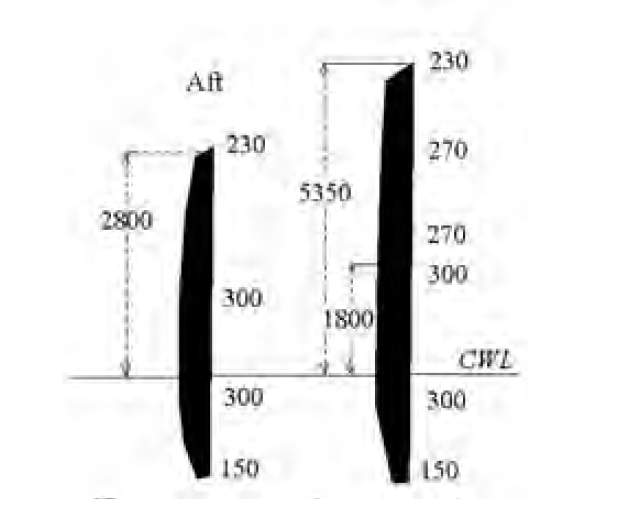
But the most important thing was elsewhere - as we said earlier, the “Seidlitz” (and other German battle cruisers) had one very vulnerable spot - their thickest part of the armor did not reach the level of the horizontal armor. For example, the 300 mm of the Zeidlits armored belt, with a normal displacement, rose above the water at 1,4 m, while the horizontal section of the armored deck was located at a height of 1,6 m above the waterline. Accordingly, there was a significant portion of the bead, when hit by an enemy projectile hit 230 mm armor and then hit the 30 mm armored deck. And this section, of course, was much wider than the 20-centimeter difference, because, as is known, the shells hit the board not strictly parallel to the surface of the water, but at an angle to it.
But at Derflinger, this section was significantly reduced, because the height of 300 mm body armor grew from 1,8 m to 2,2 m, of which 1,8 m were above water. That is, the border of the 300 mm section was not on the 20 cm below, but on the 20 cm above the level of the horizontal armored deck. As a result, where it was enough to penetrate 230 mm board and 30 mm bevel, for defeating boiler rooms and machine rooms of “Zeidlitz”, Derflinger defended 300 mm (in the worst case - 270 mm) armor and 50 mm bevel, because bevels compared with "Seidlits" were also strengthened.
Artillery
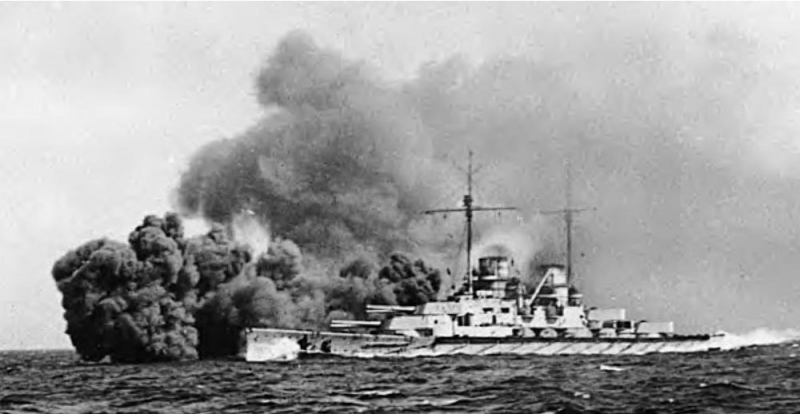 [/ Center]
[/ Center]“Derflinger” finally got the 305-mm SK L / 50, which were installed on the dreadnoughts of Hochseeflotte starting from “Helgoland”. For its time, these were extremely powerful guns, firing 405 kg with projectiles with an initial velocity of 875 m / s. Of course, you have to pay for everything - the German cannon withstood 200 shots, and this was not too much. On the other hand, the English 343-mm gun with a "heavy" projectile had a resource in 220 shots.
In foreign sources there is no consensus on how much the high-explosive German projectile weighed - 405 kg or 415 kg (the latter is indicated by G. Staff), but there are no discrepancies in its explosive content - 26,4 kg. There is some interest in the relatively low content of explosives in the German “land mines”, but perhaps the explanation is that the German projectile of this type was more like a semi-slaughter than a pure high-explosive. His detonator had a slight deceleration, which would allow the projectile to detonate at the moment of armor passage - if the projectile hit, say, an unarmored board or superstructure, it exploded through 2-6 meters after breaking through a light obstacle. An armor-piercing projectile was completed 11,5 kg BB.
The maximum angle of elevation was 13,5 degrees, while providing a range of 19 100 m or about 103 cable. Subsequently (after the battle of Jutland), the angle was brought to 16 degrees, getting a range of 110 KB. Ammunition was slightly increased compared with the previous types of battlecruisers and was 90 shots on the gun, while the 65 projectiles were armor-piercing and 25 - high-explosive.
The average caliber of the “Derflinger” was represented by twelve 150-mm SK L / 45, which fired 45,3 kg with projectiles with an initial speed of 835 m / s. Initially it was supposed to install 14 of such guns on the ship, but later, because of the need to allocate a place on the Fram cistern, they limited themselves to 12 guns. In principle, the guns themselves were no different from the Zeidlitz cannons, and the calculations (eight people) remained the same number, but there were changes in their “jobs”, which is why the artillerymen did their work a little differently than they were before the same result. Ammunition was 160 shells on the gun.
Mine weapons consisted of eight 88-mm SK L / 45, located behind the shields, another four 88-mm L / 45 guns were anti-aircraft, the latter were located near the first pipe. Torpedo armament was represented by four 500-mm underwater vehicles, ammunition was 12 torpedoes.
Power plant
The principal difference from the previous German battlecruisers was that on the “Derflinger” from 18 of Schulz-Thornycroft boilers it was coal 14, and the remaining 4 were oil. The Germans “resisted” the transition to oil for a very long time and their arguments were weighty: it was believed that placing the oil on the ship was dangerous, while the coal pits created additional protection, while Germany could not count on replenishing pre-war oil reserves during the war, threatened with its deficiency. However, the innovations of the “Derflinger” demanded weight compensation, and the main reason why the newest battlecruiser received four oil-fired boilers was to save on its displacement.
The power plant "Derflinger" had a rated power 63 000 hp In other words, despite the fact that the normal displacement of the “Derflinger” should have been 26 600 t, which on the 1 612 t is greater than the design displacement of the “Seidlitz”, the power of the power plant remained unchanged. Many sources indicate that Derflinger was designed for 26,5-nodal speed, G. Staff asserts that under 25,5 is a knot. It is difficult to say who is right here, because, on the one hand, a decrease in speed with increasing displacement looks quite logical, but on the other hand, the Germans could make additional efforts to maintain speed, such as optimizing a theoretical drawing and so on.
As a result, the Germans turned out to be even more difficult to say because, “Alas, the Derflinger” did not pass the test cycle. The fact is that the speed of the large ships of Germany was traditionally determined on the Neyrug measuring mile, which fully complied with all the requirements for such tests, but from the beginning of the war it was considered unsafe. As a result, “Derflinger” was sent to the Belt measured mile, where the sea depth was only 35 m. It is known that movement at shallow depths significantly reduces the speed of the ship and it is not surprising that, having given out the power of 76 034 machines, Derflinger achieved only 25,8 knots. speed. Calculated, this result corresponded to 28 nodes on "deep water". The Germans themselves considered the Derflinger type battlecruisers to be the fastest of all built.
The total fuel supply was 3 500 tons of coal and 1 000 tons of oil. Estimated travel range in this case was to be:
3 100 miles at speed 24,25 knots .;
5 400 miles with 16 knots .;
5 600 miles with 14 knots.
Seaworthiness of the ship ... here, I must say, there are questions. Of course, the Germans themselves spoke of her exclusively in superlatives. Nevertheless, the author of this article came up with allegations that at full speed the “Derflinger” feed was completely hidden under water, so that the sea water was splashing at the barbets of the feed towers of the main caliber. In confirmation of this in one of his monographs VB Husbands leads a charming photograph of the cruiser's stern:
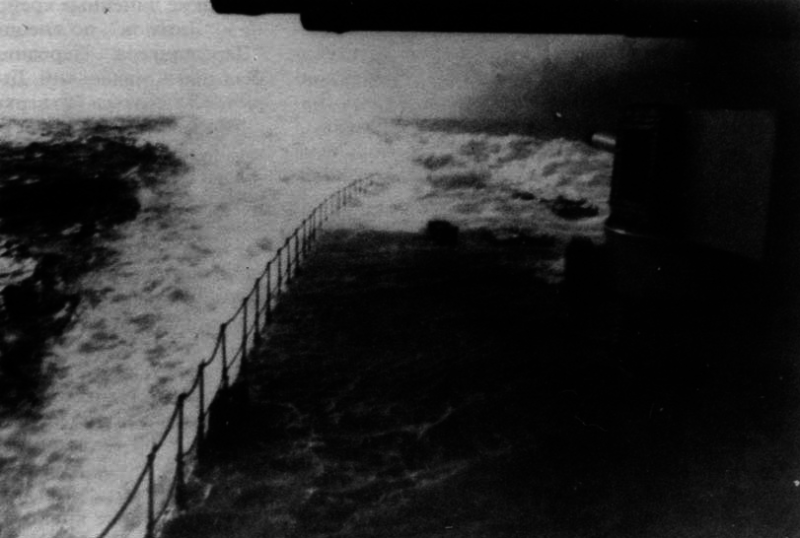
Yet, apparently, Derflinger’s seaworthiness was enough for operations in the North Sea, at least no evidence of the author’s reverse was found.
In general, the following can be said about “Derflinger”. Despite the seemingly insignificant differences from the Seydlitz preceding it (the maximum thickness of the armor belt is the same 300 mm, the same power of the power plant, tools, larger by an inch with a smaller number of them, the displacement is increased by only 1,6 thousand tons) the Germans managed to create not even significantly, but radically the best ship. “Derflinger” can be safely considered the representative of the next, second generation of Germanic battlecruisers - well, we will do a comparison with his English rivals a bit later.
Продолжение следует ...
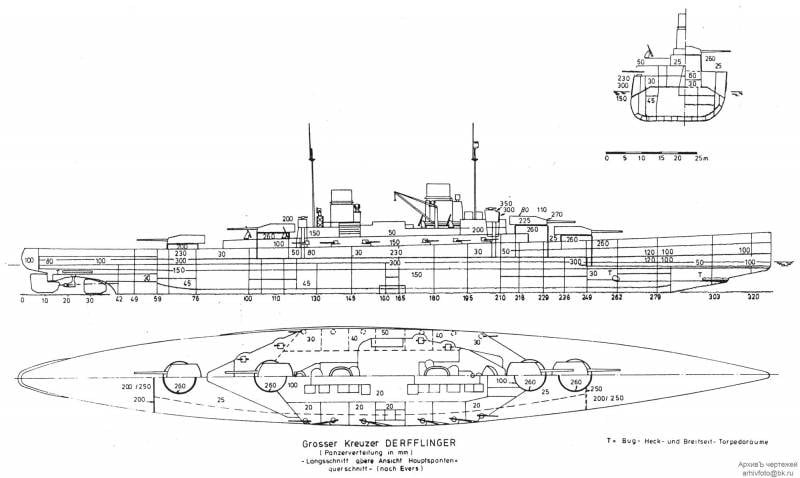
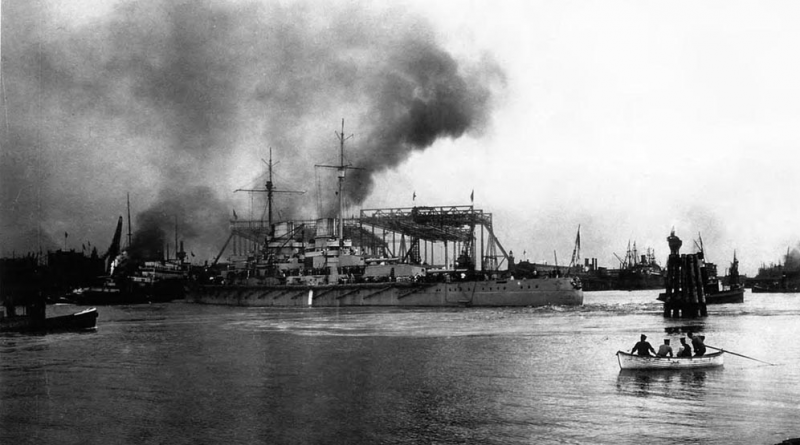
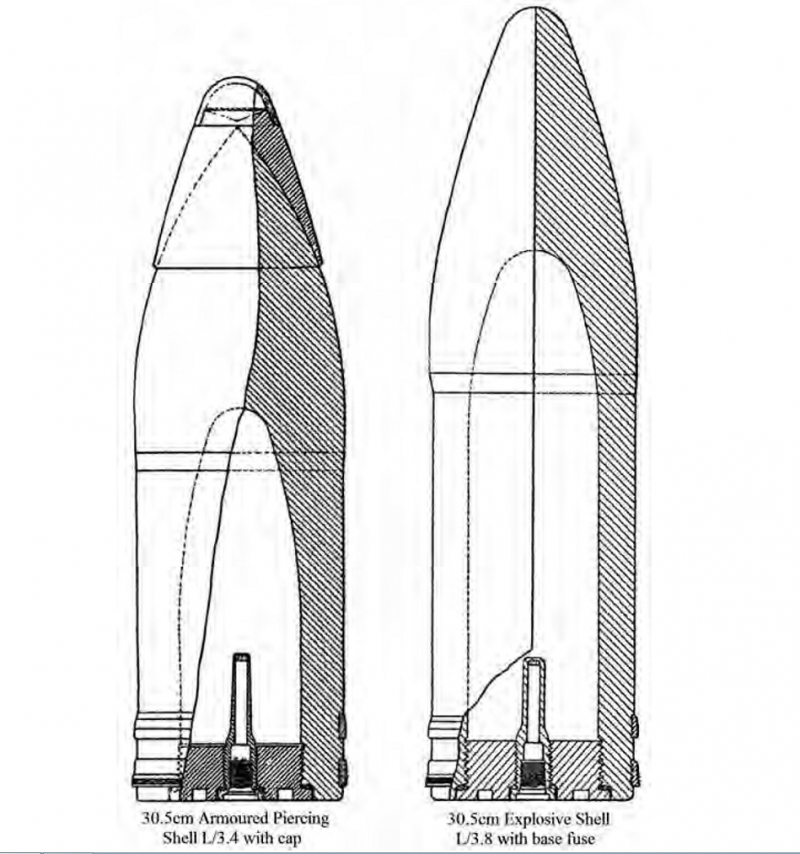
Information